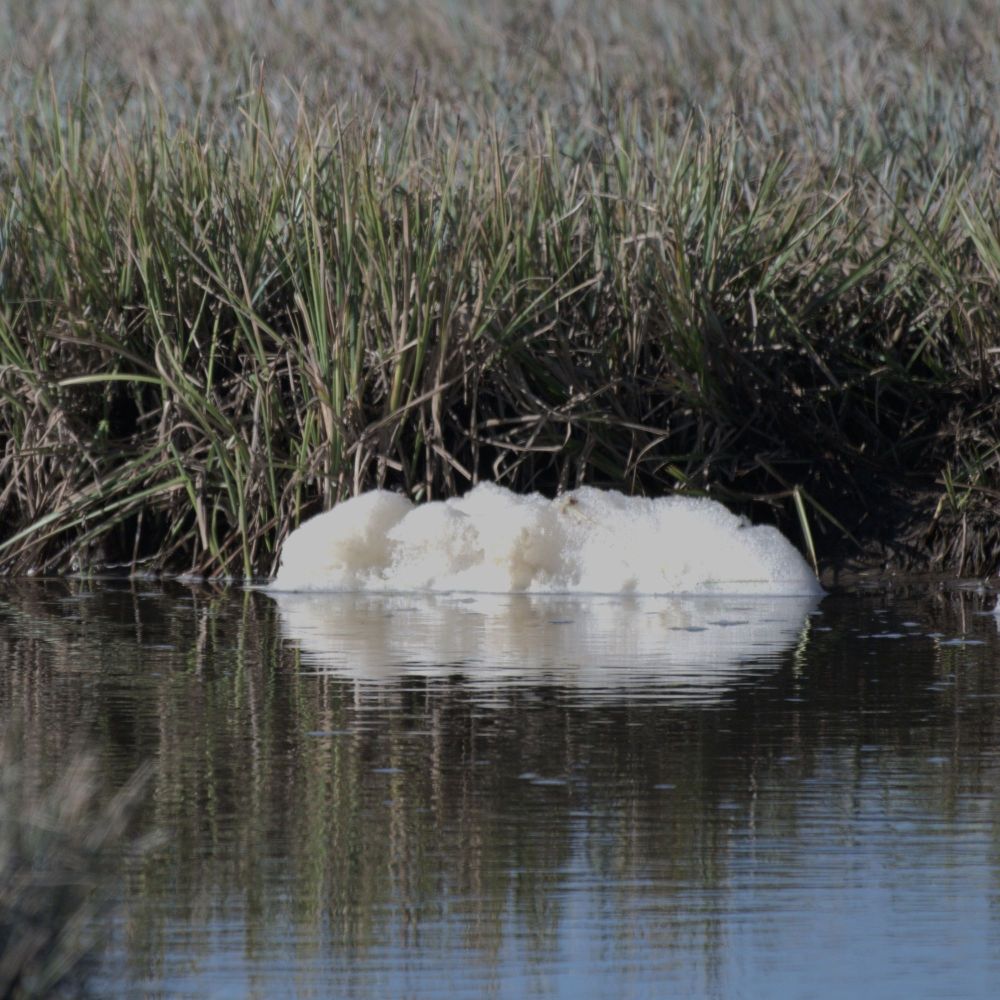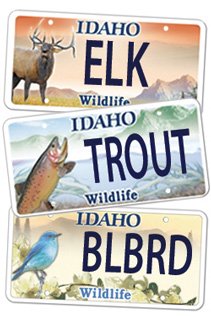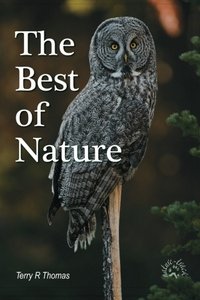Foaming Water

©Terry R. Thomas/www.nature-track.com
Foam forming on a creek does not mean the creek is dirty or polluted. It is a natural process.
In the past two weeks, on two different streams, I have noticed little patches of foam floating down stream. I am sure everyone has seen this as well. How and why does this foam form? Is it dangerous, natural, or manmade? Should we be concerned about it?
Most of the time, foam formation on streams, lakes, and even seashores, is a natural event. The process starts with the decay of natural materials such as leaves, sticks, mosses, and even animal carcasses and waste. As these decay, the resulting base components, often referred to collectively as dissolved organic compounds or DOC for short, act as surfactants.
A surfactant reduces or weakens the surface tension between water molecules. This lower surface tension allows air bubbles to form and water molecules to separate, giving the foaming process a place to start. The churning of the water due to wind or coursing over rocks provides the agitation to help the air bubbles to escape and the DOCs create the film that captures the escaping air. The result is foam, much like beating egg whites into a meringue with a handheld mixer.
As the process continues, the foaming mass grows. In streams and rivers, foaming masses can join, collecting in eddies and backwaters. On lakes, the foam may form long windrows on the water and eventually wash ashore. On seashores, the foam may be washed into long piles on the beaches.
Since this is a natural process, foam typically is not harmful, even though the foam itself may look dirty and may smell fishy or earthy. Natural foam is usually a light tan to brown in color owing to the source of its DOCs and the same is true for the odor. It is all natural, but the process of decay is not always pleasant. A substantial amount of foam may indicate a high level of nutrients in a stream which is pollution.
Natural foams are not just a curiosity. They create microenvironments, offering ecological niches for various organisms, including insects and microorganisms, contributing to biodiversity. Sitting under a patch of foam is also a good place to hide from overhead predators.
Although foam on water may be seen almost any time, it is most common during the spring and again in the fall. During the spring, runoff carries more DOCs and the more turbulent water increases the release of air bubbles. In the fall, there is more decaying matter. After a prolonged rain that brings more DOCs from the surrounding watershed you can also expect to see more foam.
Sometimes this natural foam can interact with other events such as a blue-green algal bloom to create a foam that can be toxic to wildlife. One such event occurred several years ago on the Oregon coastline, killing thousands of seabirds.
Foam can also form from human-caused pollutants. This foam is often quite different. It tends to be white and have a perfume smell (strange, I think of pollution as being dirty and smelly) that often comes from laundry detergent and soaps.
During the 1950’s and 60’s detergent-caused foaming events were commonplace and a huge problem. That led to the development of laws requiring all foaming agents to be bio-degradable so they quickly breakdown and don’t cause visible issues.
There are other chemicals that cause foaming as well. These are not foams that you want your kids playing in as they can house toxic chemicals and heavy metals. I remember seeing a sign next to a foamy creek near the National Zoo in Washington D.C. warning to stay out of the polluted water.
While knowing about why there is natural foam on water is not going to change your life, if you are like me, it does answer one of those nagging life questions. Some days you just can’t help but learn something.
Help Idaho Wildlife
When we traveled across the state in October 2017, we visited most of the Idaho Department of Fish and Game wildlife management areas. Most of the vehicles we saw using the wildlife management areas did not have wildlife plates. Buying wildlife plates is a great way for non-hunters and hunters alike to support wildlife-based recreation like birding.
C'mon folks, let's help Idaho's wildlife by proudly buying and displaying a wildlife license plate on each of our vehicles!
See below for information on Idaho plates. Most states have wildlife plates so if you live outside Idaho, check with your state's wildlife department or vehicle licensing division for availability of state wildlife plates where you live.
And tell them that you heard about it from Nature-track.com!

Wildlife License Plates
Great news! as of 2024, there are three NEW designs for license plates. They still are bluebird, cutthroat trout and elk, but they are beautiful.
Idaho Wildlife license plates provide essential funding that benefits the great diversity of native plants and wildlife that are not hunted, fished or trapped—over 10,000 species or 98% of Idaho’s species diversity. Game species that share the same habitats (such as elk, deer, antelope, sage-grouse, salmon, trout) also benefit from these specialty plates.
No state tax dollars are provided for wildlife diversity, conservation education and recreation programs. Neither are any revenues from the sale of hunting or fishing licenses spent on nongame species. Instead, these species depend on direct donations, federal grants, fundraising initiatives—and the Idaho Wildlife license plates.
Both my vehicles have Bluebird Plates. I prefer the bluebird because the nongame program gets 70 percent of the money from bluebird plates, but only 60 percent of the money from elk and trout plates - 10 percent of the money from elk plates supports wildlife disease monitoring and testing programs (to benefit the livestock industry) and 10 percent from cutthroat plates supports non-motorized boat access.
Incidentally, in 2014, the Idaho Legislature denied the Department of Fish and Game the ability to add new plates or even to change the name of the elk and cutthroat plates (very specific) to wildlife and fish plates, a move that would have allowed for changing images occasionally and generating more revenue. It would seem that they believe that we Idahoans don't want a well funded wildlife program.
I think it is time we let the Legislature know that Idahoan support wildlife funding and that we would like to see these generic plates come to fruition.

"WOW. What a phenomenal piece you wrote. You are amazing." Jennifer Jackson
That is embarrassing, but actually a fairly typical response to my nature essays. Since The Best of Nature is created from the very best of 16 years of these nature essays published weekly in the Idaho Falls Post Register (online readership 70,000), it is a fine read. It covers a wide variety of topics including humorous glimpses of nature, philosophy, natural history, and conservation. Readers praise the style, breadth of subject matter and my ability to communicate complex and emotional topics in a relaxed and understandable manner.
Everyone can find something to love in this book. From teenagers to octogenarians, from the coffee shop to the school room, these nature essays are widely read and enjoyed.
Some of the essays here are my personal favorites, others seemed to strike a chord with readers. Most have an important message or lesson that will resonate with you. They are written with a goal to simultaneously entertain and educate about the wonderful workings of nature. Some will make you laugh out loud and others will bring a tear to the eye and warm your heart.
Readers Write:
"You hit a home run with your article on, Big Questions in Nature. It should be required reading for everyone who has lost touch with nature...great job!" Joe Chapman
"We enjoyed your column, Bloom Where Planted. Some of the best writing yet. The Post Register is fortunate to have your weekly columns." Lou Griffin.
To read more and to order a copy, click here or get the Kindle version
Copies are also available at:
Post Register
Island Park Builders Supply (upstairs)
Barnes and Noble in Idaho Falls
Harriman State Park, Island Park
Museum of Idaho
Valley Books, Jackson Wyoming
Avocet Corner Bookstore, Bear River National Wildlife Refuge, Brigham City, Utah
Craters of the Moon National Monument Bookstore, Arco, Idaho